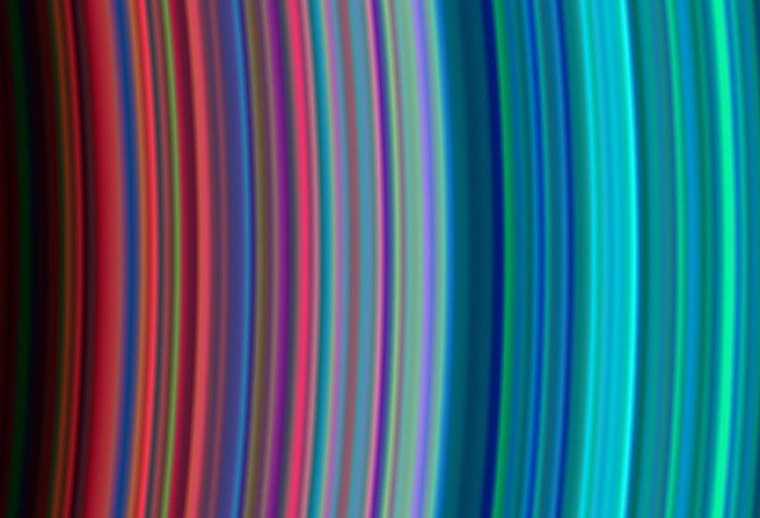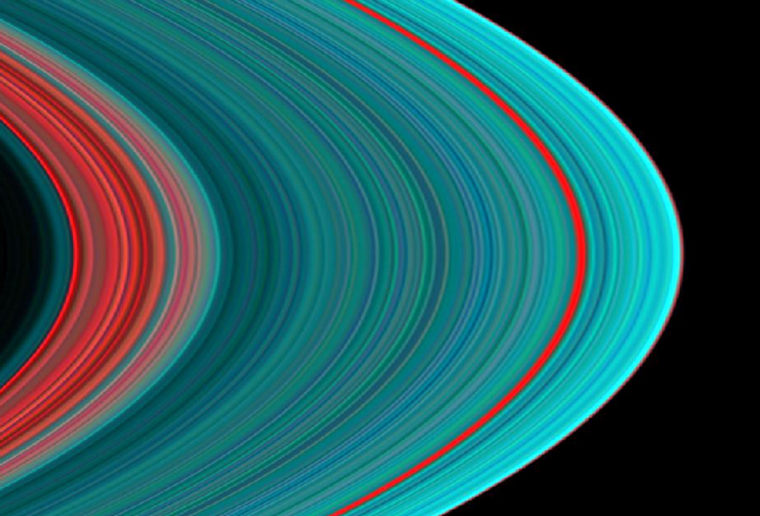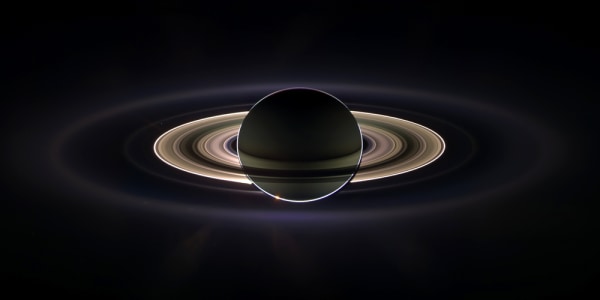The rings of Saturn are part of a young and evolving system, according to the latest observations that suggest a snowball fight is going on around the giant planet.
Portions of the rings, which are predominantly made of ice, may be only 10 million to 100 million years old, which is a brief period of time compared to the 4.5 billion-year-old solar system.
Data from the Ultraviolet Imaging Spectrometer on the Cassini space probe show fluctuations in the amount of neutral gas surrounding the planet. In one instance, oxygen levels increased by about 50 percent in a region around the outermost E ring. Scientists aren't sure what's going on.
"A possible explanation for the fluctuation in oxygen is that small, unseen icy moons have been colliding with Saturn's E ring," said Larry Esposito from the University of Colorado at Boulder.
These smaller satellites can't be seen with current technology, but astronomers assume they are there from the distribution of larger moons and other recent Cassini data that have suggested the presence of unseen moons influencing the shape of the rings.
Astronomers have long assumed Saturn's rings are composed of various-sized objects, from tiny frozen grains to mountain-sized chunks of ice and rock.
The smashing of giant snowballs produces small grains of ice, the thinking goes. The increased surface area speeds up a process by which plasma particles — essentially superheated gas — zip along Saturn’s magnetic field and strip oxygen atoms from the ice.
Besides helping release oxygen, though, the breakup of these icy moons may also explain how the rings maintain their youthful appearance.
Plasma system 'eats' rings
During Cassini’s approach to Saturn, the ultraviolet detector imaged a large cloud of neutral oxygen in the shape of a doughnut, or torus, ringing the planet.
Extending from three to eight times the radius of Saturn, the cloud approximately overlaps the E ring, but it is much wider — puffing out of the plane by a distance of two Saturn radii. The radius of Saturn is about 36,000 miles (58,000 kilometers).

The oxygen atoms in the torus absorb solar radiation and re-emit light in the ultraviolet part of the spectrum. Fluctuations in re-emitted light are due to changes in the number of oxygen atoms.
A large peak in the number of oxygen atoms was observed around February 2003. The implication is that the plasma stripped away about a billion pounds (500 million kilograms) of oxygen from the outermost E ring over a two-month period.
"Presumably, what is happening is the plasma system is eating the rings," said Donald Shemansky from the University of Southern California. "It does this by eroding water from the grains."
In a telephone interview with Space.com, Shemasky explained that the plasma particles can penetrate only a short distance into the ice, so the erosion rate increases with surface area. A chunk of material has more surface area when it is broken into smaller fragments.
The large fluctuation seen in the oxygen data presumably followed the breakup of a big chunk of ice — either from a collision with another icy moon or an impact from a meteorite.
Shemansky and his colleagues have estimated from the loss rate of oxygen that the entire mass in the outermost E ring would disappear in a matter of 100 million years, if there were nothing to replenish it.
"There has to be regeneration," said Shemansky. "Otherwise, [the rings] would drop dead on us."
Regeneration
The same process that may be exposing the ice to the plasma may be rejuvenating the rings as well. Evidence for this comes from the beautiful bands of colors in the rings.
Slideshow 14 photos
Best of Cassini
The colors are thought to be due to "pollution." When a meteor crashes into Saturn, it can deposit some of its material in the rings. Lower-density bands in the rings would get dirtier faster, and the more gunk on the ice, the darker the band will be.
But because the meteor dirt would spread out over time, this mechanism cannot explain how thin the color bands are — unless clean ice is added to the rings from time to time.
"The evidence indicates that in the last 10 million to 100 million years, fresh material probably was added to the ring system," said Esposito, the lead author of an article appearing Dec. 16 in the online version of the journal Science.
The interiors of moonlets would be uncontaminated by the incessant meteor bombardment. The researchers, therefore, explain the brightness of the A ring by postulating the relatively recent demise of a moon with a radius of about 12 miles (20 kilometers).
"Both the oxygen fluctuation and the spectral variation in Saturn's rings support a model of ring history in which small moons are continually destroyed to produce new rings," Esposito said.
In the midst of it
According to Shemansky, the moon-smashing idea is still speculative. There are other processes that might be involved, such as volcanoes on Saturn’s larger moons spewing out slushy material.
His team is continuing to monitor the oxygen around Saturn, but now from much closer — since Cassini is now in orbit around the planet.
"We are in the midst of it," he said, referring to the oxygen torus.
From this vantage point, they hope to map out the three-dimensional structure of the neutral gas. They also want to determine how often the oxygen level fluctuates.
"Hopefully, we’ll see more events," Shemansky said. "We only have one right now."

